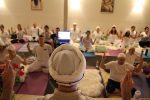Learn to Meditate
Yogic science says there are specific lengths of time needed for certain effects during meditation:
3 minutes
affects the electromagnetic field, the circulation and stability of the blood.
11 minutes
begins to change the nerves and the glandular system.
22 minutes
balances the 3minds, and they begin to work together.
31 minutes
allows the glands, breath, and concentration to affect all the cells and rhythms of the body. It affects the 3 gunas, 31 tattvas and all layers of the mind`s projection.
62 minutes
changes the gray matter in the brain. The subconscious ‘shadow mind’ and the outer projection are integrated.
2 ½ Hours
changes the psyche in its correlation with the surrounding magnetic field so that the subconscious mind is held firmly in the new pattern by the surrounding universal mind.
To master the effects of a meditation, practice it as a sadhana, a daily discipline. This will develop a life-promoting habit. Habit controls us so much that it is said that we can actually change our destiny by changing our habits. According to yogic science, the human mind works in cycles. We can use various cycles to help replace unwanted patterns of behavior (mental or emotional habits), with new, more positive ones. One commits to a particular meditation or Kriya for a specific time:
- it takes 40 days to change a habit
- it takes 90 days to confirm the habit
- in 120 days , the new habit is who you are
- in 1,000 days, you have mastered the new habit
Try to meditate at the same time each day.
There are several different places to focus the eyes while meditating, depending on which meridians and parts of the brain are to be stimulated:
At the 3rd eye point:
we stimulate the Sushumna which affects the pituitary gland (intuition is developed)
At the tip of the nose :
all 3 main energy channels (Ida, Pingala, Sushmuna) get to a center of balance. This stimulates the pineal gland and the frontal lobe of the brain (new energy pathways are created in the brain patterns).
At the Moon center (tip of the chin) :
this is cooling, calming (you see yourself clear)
At the Crown chakra:
you look “through” the top of the head. (this stimulates the pineal gland and the crown energy center)
The mantras can be chanted in the three languages of consciousness:
- Aloud (the voice of the human) – awareness of the things of the world
- Whisper (the voice of the lover) -experiencing the longing to belong
- Silent (the voice of the Divine) – meditate on Infinity or mentally vibrate
There are 3 key elements that can enhance the experience of chanting mantras:
- Rhythm – maintain a crisp ,precise rhythm, the correct number of beats for the specific mantra
- Projection – project from the purity of your soul, be conscious of which chakra you are projecting from
- Pronunciation – use the correct pressure of the tongue on the meridian points; maintain the correct balance and rhythm of the syllables making the words.
Here`s why we roll/touch with the tongue the roof of the mouth when we chant: the upper palate forms the roof of the mouth; it consists of 2 parts: the hard palate (roof of the mouth) and the soft palate. There are 84 meridian points located on the hard palate. 32 pairs of points (64 points) are located on the hard palate surface directly behind and along the inside of the teeth (4points with each tooth). The other 20points are located in a curve or “U” shape on the central part of the palate, with 10 pairs of points along each side.
The movement of each part of the tongue stimulates these meridian points; the points are like a keyboard input to a computer. The hypothalamus receives the impulses and regulates chemical messengers that go to all vital areas of the brain and body. Thus we can regulate vital functions of the body, moods, emotional behavior, sexuality. One can conquer depression, enhance intelligence and intuition and open the power of compassion.




